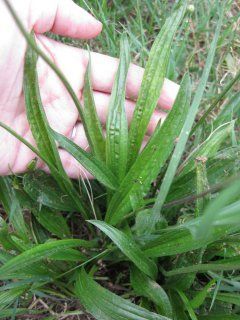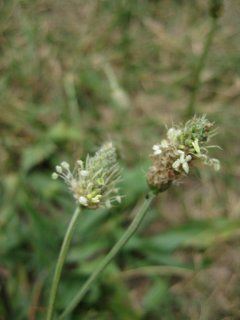calee
Chillin' In The Garden
So last year, I noticed these strap-leaved plants growing around the yard. I started watering some of them to encourage them to grow because I thought they were so pretty. Then they bloomed! Adorable 1" little green flower heads at the top of 8-12" stalks with little sputnik-like rings of tiny white stamens sticking out. I started scheming about transplating them into my beds...
This year, I took a leaf sample to the farmer's market and checked with some of the local experts. It's narrow-leaved plantain. I had NO idea plantain could have such narrow leaves and such short flower spikes! The plantain I was familiar with had wide, almost spade-like leaves and 6" long flower spikes at the top of a foot-long stem.
So, am I still planning on transplanting it into my flower bed? Totally!
This stuff rocks. You can make a poultice by crushing the leaves and putting them right on on stings, bug bites, scratches, sunburn, and rashes- including diaper rash on babies and poison ivy. To save it for winter use, crush the leaves into a clean jar, fill the jar with enough vegetable oil to cover, put the lid on, and leave it in the sun for a week or two. Strain the oil. Either bottle it into sterilized jars or warm it gently on the stove with a little beeswax and pour it into shallow jars for a light salve. I've had friends sautee it and eat it, but I haven't done it yet. Maybe next spring when everything's more tender.
And just because I know you are tapping your foot impatiently at your computers wondering what the heck this wonderful little herb looks like:


This year, I took a leaf sample to the farmer's market and checked with some of the local experts. It's narrow-leaved plantain. I had NO idea plantain could have such narrow leaves and such short flower spikes! The plantain I was familiar with had wide, almost spade-like leaves and 6" long flower spikes at the top of a foot-long stem.
So, am I still planning on transplanting it into my flower bed? Totally!
This stuff rocks. You can make a poultice by crushing the leaves and putting them right on on stings, bug bites, scratches, sunburn, and rashes- including diaper rash on babies and poison ivy. To save it for winter use, crush the leaves into a clean jar, fill the jar with enough vegetable oil to cover, put the lid on, and leave it in the sun for a week or two. Strain the oil. Either bottle it into sterilized jars or warm it gently on the stove with a little beeswax and pour it into shallow jars for a light salve. I've had friends sautee it and eat it, but I haven't done it yet. Maybe next spring when everything's more tender.
And just because I know you are tapping your foot impatiently at your computers wondering what the heck this wonderful little herb looks like:


